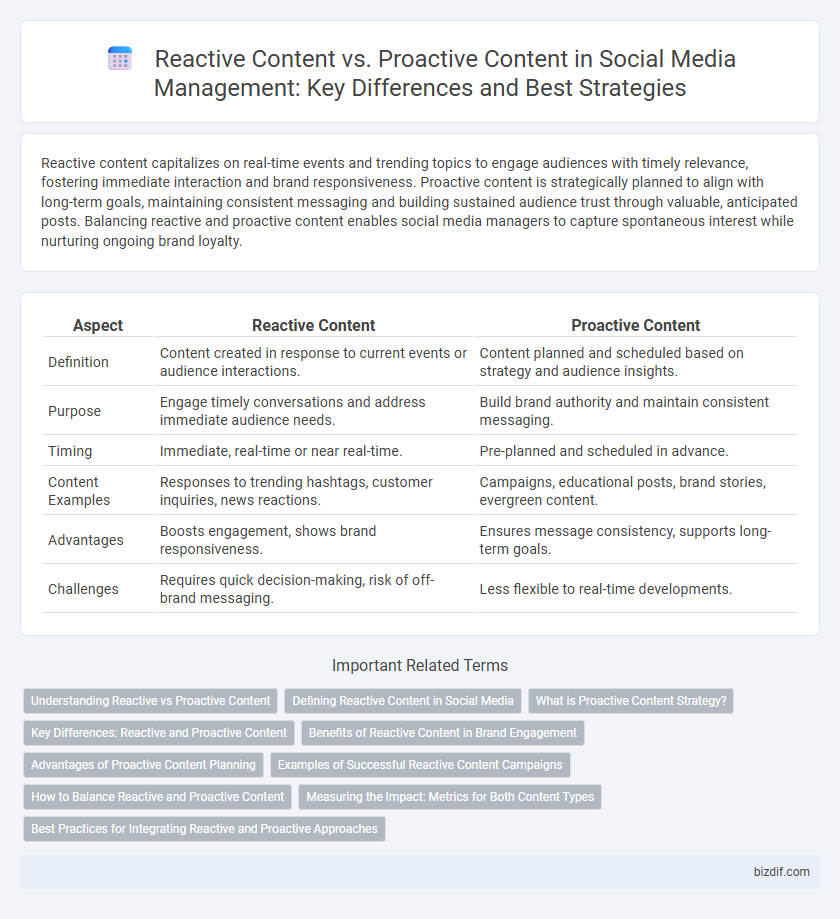Reactive content capitalizes on real-time events and trending topics to engage audiences with timely relevance, fostering immediate interaction and brand responsiveness. Proactive content is strategically planned to align with long-term goals, maintaining consistent messaging and building sustained audience trust through valuable, anticipated posts. Balancing reactive and proactive content enables social media managers to capture spontaneous interest while nurturing ongoing brand loyalty.
Table of Comparison
| Aspect | Reactive Content | Proactive Content |
|---|---|---|
| Definition | Content created in response to current events or audience interactions. | Content planned and scheduled based on strategy and audience insights. |
| Purpose | Engage timely conversations and address immediate audience needs. | Build brand authority and maintain consistent messaging. |
| Timing | Immediate, real-time or near real-time. | Pre-planned and scheduled in advance. |
| Content Examples | Responses to trending hashtags, customer inquiries, news reactions. | Campaigns, educational posts, brand stories, evergreen content. |
| Advantages | Boosts engagement, shows brand responsiveness. | Ensures message consistency, supports long-term goals. |
| Challenges | Requires quick decision-making, risk of off-brand messaging. | Less flexible to real-time developments. |
Understanding Reactive vs Proactive Content
Reactive content responds directly to current trends, news, or audience interactions, boosting real-time engagement by addressing immediate interests. Proactive content is strategically planned and designed to align with long-term goals, brand messaging, and anticipated audience needs, ensuring consistent value and message control. Understanding the balance between reactive and proactive content allows social media managers to optimize engagement while maintaining brand consistency.
Defining Reactive Content in Social Media
Reactive content in social media refers to posts or responses created in direct reaction to current events, trends, or audience interactions, ensuring timely relevance. This type of content leverages real-time opportunities to engage users by addressing trending topics, customer feedback, or sudden industry changes. Effective reactive content boosts brand responsiveness, fostering stronger connections and increasing visibility across platforms.
What is Proactive Content Strategy?
Proactive content strategy involves creating and distributing tailored content that anticipates audience needs and industry trends to drive engagement and brand authority. This approach relies on data analytics, audience insights, and forward-looking planning to craft messages that align with future opportunities and challenges. By focusing on proactive content, brands can establish thought leadership, foster loyal communities, and achieve sustained growth across social media platforms.
Key Differences: Reactive and Proactive Content
Reactive content responds to current events, trends, or audience feedback, enabling timely engagement and relevance in social media management. Proactive content is strategically planned to shape brand messaging and drive long-term goals, focusing on consistency and targeted campaigns. Key differences include timing, purpose, and adaptability, with reactive content emphasizing immediacy and responsiveness, while proactive content prioritizes forecasting and controlled narrative alignment.
Benefits of Reactive Content in Brand Engagement
Reactive content boosts brand engagement by addressing current trends and customer conversations, increasing relevance and timely interaction. It fosters authentic connections by responding directly to audience needs and feedback, enhancing trust and loyalty. This immediacy often leads to higher shareability and organic reach, amplifying brand visibility across social platforms.
Advantages of Proactive Content Planning
Proactive content planning enables brands to align social media posts with business goals, ensuring consistent messaging that drives audience engagement. It allows marketers to anticipate trends and customer needs, resulting in timely and relevant content that enhances brand authority. This strategy also optimizes resource allocation, reducing last-minute efforts and improving overall campaign effectiveness.
Examples of Successful Reactive Content Campaigns
Successful reactive content campaigns include Oreo's "Dunk in the Dark" tweet during the 2013 Super Bowl blackout, which quickly capitalized on an unexpected event to engage millions. Dove's Real Beauty campaign often responds to trending conversations about body positivity, creating timely content that resonates deeply with audiences. These examples demonstrate how leveraging real-time events can amplify brand visibility and foster authentic engagement.
How to Balance Reactive and Proactive Content
Balancing reactive and proactive content in social media management requires allocating time for real-time engagement while maintaining a strategic content calendar focused on long-term brand goals. Use social listening tools to identify trending topics for reactive posts that enhance relevance and audience connection, while consistently producing planned content that strengthens brand identity and messaging. Monitoring analytics enables adjustment of this balance to maximize engagement and sustain audience interest.
Measuring the Impact: Metrics for Both Content Types
Measuring the impact of reactive content relies heavily on real-time engagement metrics such as shares, comments, and immediate sentiment analysis to gauge audience responsiveness during trending events. Proactive content effectiveness is best tracked through long-term performance indicators like follower growth, brand awareness uplift, and conversion rates to assess sustained audience interest. Combining analytics from both content types using tools like social listening and campaign tracking software provides a comprehensive view of social media strategy success.
Best Practices for Integrating Reactive and Proactive Approaches
Balancing reactive and proactive content is essential for effective social media management, ensuring timely engagement while maintaining a strategic brand narrative. Integrate real-time audience feedback and trending topics with pre-planned campaigns by scheduling proactive posts and reserving flexible time slots for reactive content. Use analytics tools to monitor performance, enabling data-driven decisions that optimize both engagement rates and brand consistency across platforms.
Reactive content vs Proactive content Infographic

 bizdif.com
bizdif.com